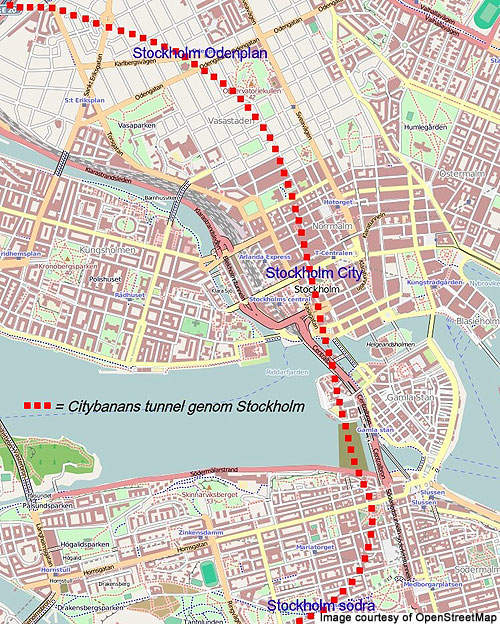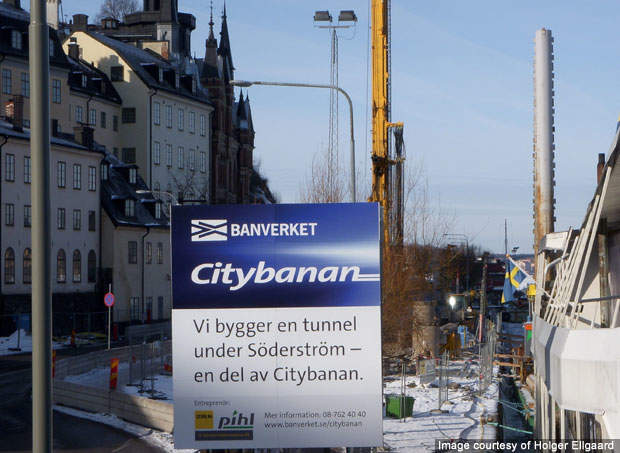The Stockholm City Line or Citybanan is a 6km-long underground railway line under construction in Central Stockholm, Sweden. It includes a 130m² of double rail track, a parallel service tunnel and two underground stations. Commuter trains will run on the Stockholm City Line while long distance trains will operate from the existing tracks so that the rail traffic congestion will be reduced.
The line is planned for completion in 2017. It will be owned and operated by the Swedish Transport Administration (STA).
The total cost of the project, including the construction of the tunnel and stations, is estimated to be SEK16.8bn ($2.4bn) which represents the largest investment in Stockholm’s rail system since 1950.
Line routes
The Stockholm City Line, which will be enclosed in a concrete tunnel, will consist of two lines that will connect Tomteboda station to Stockholm South station.
Connecting the south to the north of the Citybanan tunnel, the first line will start from Stockholm South station at Sodermalm and continue through underground stations at Riddarfjarden at Soderstrom, Riddarholmen and Riddarfjarden at Norrstrom before finally reaching the new City station.
The other line will begin at the new City station and pass through Norrmalm to reach Odenplan station, which in turn is connected to the Northern Main Line at Tomteboda passing via Vasastaden.
Project
In an effort to ease the rail traffic congestion at Stockholm, a twin-track tunnel construction project called Stockholm City Line was proposed by the Swedish State Railway in 1988. The project was suspended at that time due to high cost.
The Government of Sweden, after the 2006 general elections, unveiled a proposal to build a third railway track passing through the city rather than building the tunnel.
After reassessing the project, however, experts recommended that the Government build the tunnel. The project was finally approved for financing by the Swedish Rail Administration and Storstockholms Lokaltrafik in 2006.
The STA began construction of the City Line with co-operation from the City of Stockholm, Stockholm County Council and Stockholm Public Transport. It will construct a new underground rail tunnel at a depth of 10m to 40m. About 1.5m m³ rock will be excavated to build the tunnel.
A 370m-long section of the tunnel will be submerged in the waters of Söderström between Riddarholmen and Söder Mälarstrand. The submerged portion will be 21m-wide. The submerged portion will be built by the E. Pihl & Son consortium.
Grontmij in conjunction with Sweco was awarded a contract to execute preliminary design of two stations as well as final design of one station and part of the tunnel.
Once operational, the new lines will double the track capacity in Stockholm.
Infrastructure
Two underground stations (Stockholm City and Stockholm Odenplan), which act as central stations for commuter trains, will be built within the tunnel to ease the city centre rail traffic. The Stockholm City station will be located beneath the T-Centralen, which is the central station of the Stockholm Metro. The Odenplan station, which will be built below the Karlberg Station, will be used for passenger train and metro services.
The Stockholm City station will have two platforms and two subsurface station halls. Escalators will be built in both stations to provide direct access to the Stockholm Metro.
The rail tracks between Arsta and Alvsjo will be renovated and stored for future commuter train traffic. A 1.4km-long railway bridge will be built at Arsta with an investment of SEK315m. It will be designed by Centerlöf & Holmberg and engineered by Cowi.
Contracts awarded
Ramboll will design the tunnel, smoke and heat ventilation. The stretch between Sodar Malarstrand and Sodra stations is also being designed and built by Ramboll. Nitro Consult and Ansvarsbesikting will carry out ground investigations, vibration measurements, noise and structure-borne sound, risk analysis, blasting, excavation, and design and construction documentation.
WSP was awarded a £15m contract in July 2007 to construct part of the City Line in the city area and the Stockholm City Station. The company will also conduct a geotechnical investigation and construct the northern half of the project which comprises about 2km-long stretch.
AF Group was awarded a contract worth SEK200m (€22m) in July 2007 to install the tracks, electrics, and signalling and telecommunication systems.
The construction has been divided into eight sections for the purpose of contracting.
Peab was awarded an SEK149m contract by STA on 8 May 2009 to build the first section of the tunnel and concrete troughs. Work began in 2009 and is expected to be completed by 2012.
Bilfinger Berger was awarded a contract worth €100m in May 2009 to build the second section, which is 1.9km long. The company was also contracted to build the seventh section.
ODEN will build the 1km-long third section of the tunnel at Norrmalm at a cost of $314m.
NCC was awarded the fourth section, with a contract worth SEK1.6bn. The contractual scope includes building a section of the tunnel at Norrström, construction of the City commuter train-station including two station tunnels, two platforms and four tracks, and connecting tunnels at Riddarholmen.
A consortium of E. Pihl & Son and Züblin Specialtiefbau was awarded an SEK1.3bn contract for the fifth and sixth sections of the project in January 2008. Construction is scheduled to begin in February 2011 and complete by December 2014.
The eighth section was awarded to Ej upphandlad.




